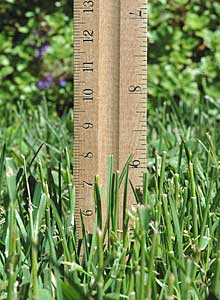|
Plant water stress, excess nitrogen and excess thatch predispose lawns to damage by chinch bug. Cultural controls for chinch bug involve changing lawn maintenance practices to relieve these conditions without changing the fundamental nature of the lawn. In general, the cultural practices advocated for control of chinch bug are simply good maintenance practices regardless of chinch bug problems.
The various cultural controls are listed more or less in order of importance and convenience (most important and convenient first). Special attention to watering the more drought stressed areas of a lawn is a priority if the lawn has been damaged by chinch in previous years, and until other cultural measures which reduce water demands (e.g., higher mowing, lower fertilizer rates) are implemented. The suggested mowing, fertilization and clean-up practices can be conducted as part of normal lawn maintenance procedures and do not involve extra work or expense. Dethatching and aeration operations are not routine operations, although some lawncare companies do conduct aeration as a regular spring practice.
1. Watering (Irrigation)
As discussed in Section IV (Factors Affecting Chinch Populations and Damage ), water stress is the single most significant factor causing lawns to be susceptible to chinch bug damage. There's lots you can do to reduce water stress by reducing demand for water (which is a much more sustainable approach than using our valuable water resources for watering a lawn) including
However, if you have had serious chinch bug problems, or just purchased a home in a new development where shallow soils and Kentucky bluegrass monocultures are the norm,
careful attention to watering can help to reduce the liklihood or severity of chinch bug attacks while you work on more sustainable approaches.
Appropriate watering
- relieves potential water stress on the grass, making it more resistant to chinch bug;
- creates an environment that is less than optimal for chinch bug and that is conducive to control by natural enemies.
If nothing else is done after an attack by chinch bug in a previous year, instituting a 'drought watch' and ensuring that the lawn is properly watered is the most important step that can be taken to guard against a repeat attack. Below, some of the main factors to consider are outlined.

Grass leaves are very efficient at intercepting rain and directing it towards the base of the plants and into the soil. |
Whether to Water and How much Watering is Required
This depends on several factors including
In regard to the last point (weather): recent years have seen an increasing frequency of unusually droughty conditions in the summer in the Maritimes, a trend that may be associated with climatic warming and is likely to continue. (See Predicted Water Deficits for HRM)
Drought Watch
A drought watch should be maintained if
- the lawn suffered from chinch bug damage in previous years;
- the lawn was recently installed in a sunny area and no particular attention was given to the depth of soil and soil quality when it was installed.
When to Watch
May through to mid-October; June and July will be most critical for the current year, watering in (a dry) fall, for the next year.
What to Watch
- The weather patterns: if there is no rain or only a light rain for a week in May to mid-June, or for only 4 or 5 days during mid-summer, the lawn may need watering (depending on soil depth, organic matter and texture).
- The grass: water stress is indicated by "a bluish-gray color of the grass or footprints that remain in the lawn for an extended period."[L17]
- The soil: "Poking a long
screwdriver or rod into the soil will reveal the depth of water penetration. Moist soil can be easily penetrated and the probe will stop when it reaches dry soil."[L18]
Poor watering practices can be more harmful than no watering at all!
Olkowski et al.[C12] comment:
"Poor irrigation practices encourage a variety of pest problems. Too often, automatic sprinklers are timed to water lawns for brief periods on a daily basis. Although this may be a good idea during the first few weeks that a lawn is getting established, ongoing daily irrigation leads to problems. Light frequent irrigations produce very shallow root systems that grass completely dependent on artificial watering, and one or tow missed irrigations can doom the lawn. In addition daily irrigations may cause leaching of minerals, resulting in weakened grass plants with a yellowish-green appearance that are more susceptible to invasions of weeds, insects and diseases.
"...It is best to irrigate only when the water supply in the soils has been depleted sufficiently to require replacement." |
What Time of Day to Water
On sunny days, the best time is early morning (e.g. 4 am onwards)
the second best, evening (about 6 pm onward). Watering during the day is inefficient. Watering at night is considered conducive to disease, however, it's better than during the day. Any time of day is okay on overcast, humid days.
How Much Water
It's better to water with a slow stream of water over a long period (3 hours plus) than to water intensively for a short period. Grass, like humans, has a limit to how fast it can drink water; put it on too fast and it will simply run off. It there is runoff, stop for an hour and then begin again.
When to Water Again
Repeat the watering only when the grass starts to show some signs of stress &/or it has been hot and dry for 4 to 5 days.
Focus on drought-prone areas
Not all lawn areas are equal. Focus on the more drought-prone areas: curbs, next to garden beds, exposed slopes etc., especially those areas where chinch outbreaks were observed in previous years. Shaded areas will need water much less often than exposed areas.
Holidays and Dormancy
One decision to make is whether to let the lawn go into dormancy in mid-summer. Sometimes summer holiday plans are the deciding factor. That's okay, but decide either to hire someone to water the lawn properly OR let it go into natural dormancy. Waffling in between can make matter worse. The following is taken from an Ontario government document:[L2]
Dormant Lawns
During extended dry periods, a lawn may turn brown and go dormant. A lawn can survive from 4 — 6 weeks in a dormant state during summer dry periods. Once the rains return the lawn will green up in 7—10 days. If the lawn is dormant:
- Check regularly for insect pests
- Keep traffic off
- Stop mowing
- Do not fertilize
A slightly different opinion on watering of dormant lawns is offered in a University of Nebraska document:[L20]
If the homeowner cannot
water, or elects not to water a
dormant lawn, a light watering
or rainfall of 0.5 inch every two
weeks will help minimize
damage to the lawn during the
dormancy period. This watering
practice will supply enough
moisture to keep crowns,
rhizomes and roots hydrated and
alive. This volume of water will
not regreen a dormant lawn,
however, it will help to insure
good recovery once rainfall
occurs later in the summer.
Do not fertilize the lawn, or
try to control weeds, insects or
diseases during drought. Stay
off the lawn as much as possible.
Just keeping the lawn alive
is the most important thing to do
during drought. (DJ)
(The above refers to Nebraska, where high summer can be considerably hotter and drier than it is in Nova Scotia.)
One benefit of a botanically diverse lawn is that many of the herbs do not go into dormancy and the lawn remains green through all but the most severe droughts without watering. (Also, broadleaved plants are resistant to chinch.)
Other Considerations & More Details
There is a lot more that could be considered, e.g. how to calibrate your sprinkler, taking into account the water capacity of the lawn system. Have a look at a few of the web articles listed in the Links section below; a few minutes doing that can save lots of time on the other end and reduce water bills.
2. Mowing
Mow High, Regularly, and Retain the Clippings
Not very long ago, close mowing and removal of clippings was standard practice for lawns. Today, most extension bulletins on lawncare stress the value of high mowing and retaining clippings.
There are several major benefits to this sort of mowing regime:
- By maintaining a high clipping height, the loss of water from the soil surface is greatly reduced, grass will be less water stressed and the need for watering will decrease.
- Only small clippings are produced and they come from the tips of the grass blades which have the least lignin and are high in water. These clippings fall quickly to the soil surface and decompose rapidly, feeding soil organisms and turning over the nutrients (nitrogen, potassium etc.) to the plants; and unlike the case when the grass is mowed very short, the clippings do NOT contribute to excess thatch and habitat for chinch.
- Recycling clippings returns tremendous quantities of nutrients to the soil and feeds soil organisms.
- Mowing high is much less stressful on grasses than mowing short, and reduces susceptibility to pests.[V1]
- Maintaining a high canopy shades out many weeds.
Some Guidelines:
- Mow at 7.5 to 9 cm height (3 to 3.5 inches) height or at the highest setting possible on the lawn mower (often 6 to 7.5 cm or 2.5 to 3 inches), except for the first and last mowings of the season when mowing height should be reduced to 4 to 5 cm (1.5 to 2 inches) to control winter mould problems.[L16]. To avoid long clippings, reduce the mowing height in several steps from mid-September onward. (To measure the height, just stick a ruler vertically on the ground and check the height of the grass blades from the soil surface).
- Apply the "one-third rule": never mow more than one-third of the grass off at any one time. Alternatively, apply the or the "1 inch" (2.5 cm) rule[L16]: mow when the grass is 1 inch above mowing height.
- It's better to mow high and frequently than to mow short and sporadically. Usually a one-time-per-week regime will do it, perhaps less frequently in mid-summer, and possibly at 4 day intervals when grass is growing very vigorously in late spring/early summer.
If the grass is left for a period and grows very tall, mow it down in steps, or mow it twice to several times to chop up the clippings.
- Recycle clippings by using a mulching mower or throw mower (no bag).
Tree leaves can also be mulch mowed rather than collected and removed from the lawn.[L32]
Other Approaches (Mowing shorter and/or less frequently)
Guidelines such as the above which advise to "Mow High and Regularly" have become almost the karma of organic lawncare. However, they really apply only to lawns in which a predominance of grass and a clean-cut appearrance are desired. If you have (and want to maintain) a lot of clover or other broadleaf species in the lawn, lawns can be mowed much shorter without damage.
To encourage plant diversity and local adaptation, stop mowing for a month or so during the torrid days of summer to allow clover and other herbs to flower and go to seed; or keep a section of the lawn as a meadow, mowing it only in the fall (or perhaps once in early June after the first flush of grass and again in fall) - that's best done with a scythe (see below).
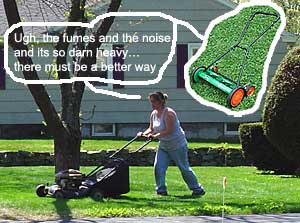 Consider Using a Reel (manual) Mower &/or a Scythe Consider Using a Reel (manual) Mower &/or a Scythe
Gas mowers are heavy, noisy and highly air-polluting. [L35] Unfortunately, a recent study revealed that cordless electric mowers are not a benign alternative: large amounts of lead are released over the life cycle of a cordless mower. [L36] Electric-cord mowers are better for the envronment, [L35, L36] but are generally heavy and awkward to handle. For the typical urban lot, a new generation of manual, reel mowers, which are half the weight or less of the clunkers of 25 years ago, has a lot to offer. Scotts - manufacturers of all types of mowers including a reel mower that mows at up to 3 inches (7.5 cm) height - has this to say about reel mowers: [L37]
"A reel mower is lighter, more maneuverable, and easier to push than non-self propelled power mowers. Since it cuts like scissors, it does not bruise or damage the blades of grass which enables you to maintain a greener, more healthy lawn."
A Swedish study [L35] found that gas mowers release 26 types of Polycyclic Aromatic Hydrocarbons, including benzo[a]pyrenes, classified as probably
carcinogenic to by the International
Agency for Research on Cancer (IARC). (That's in addition to prodigious amounts of carbon monoxide, nitrogen oxides and ozone-generating gases!) Their figures suggest they
"the (PAH)
emissions produced from a lawn mover engine during 1 h
of operation .. [are] comparable to driving a distance of more
than 150 km with a TWC* car.
*TWC: three-way catalyst exhaust after-treatment devices, standard on today's cars (but not available on lawn mowers). |
The major significant disadvantage to a reel mower according to Scotts is that it has " an extremely difficult time with tall willowy weeds such as dandelions or buckthorn. If these weeds are present in your lawn, don't be surprised if you have difficulty mowing them. This is because the mower pushes them over and they are tall enough not to spring back to between the reel and cutter bar. "
Scotts advises that "the only real solution for tall weeds is a good dose of weed and feed or mowing them before they reach their full growth." Obviously, in HRM, we should do the latter (or keep on top of the dandelion weeding).
However, there is an even better option: use a scythe to cut the tall grass or weeds down to a size that the reel mower can manage, then use the reel mower for a clean finish. With some practice, one can produce a nicely manicured lawn using only a scythe. The scythe is also an efficient, gentle and quiet replacement for whipper-snippers for cutting vegetation in awkward corners, around trees, by fencelines etc.
The Scythe: the oldest and most
environmentally friendly grass-cutting tool
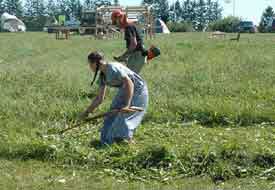
|
"The scythe in skilled hands was, until the relatively recent appearance of riding lawnmowers on the scene, the fastest way to cut homeowner-sized lawns... in my native Slovakia until at least 1992 nearly all lawns were cut with scythes."
- Peter Vido
in A Special Note on Cutting Lawns or A Letter to City Farmers
Before reel mowers, scythes were used to cut manicured estates. In many parts of eastern Europe and countries of the old Soviet block, the scythe is still an important farm and horticultural tool, while in western Europe, the scythe is being brought back as a conservation tool. It has yet to be revived as a popular tool in North America.
The Scytheconnection website (www.scytheconnection.com) provides many details about buying and using scythes, including their applications to wildflower meadows and lawns. Mowing with a scythe requires more skill than mowing with a reel or power mower, but not necessarily more strength. It is clearly the most environmentally friendly way to cut grass. In an essay entitled "The Tool with the Restorative Edge", Peter Vido puts it this way:
People have cut grass with the scythe for approximately 2500 years! Many continue simply because they like to work with their hands and/or doing so makes practical sense. In the relatively affluent countries where environmental concerns have received increased attention, the scythe also makes sense as a restorative tool.
It is therefore difficult for us to understand why, for instance, while manicuring the greenery around their homes, so many eco-conscious citizens are content adding carbon dioxide to the already crying skies.
Perhaps they haven't considered the scythe as an alternative because they never saw an accomplished mower at work. After all, television programs on the scythe in this "land of milk and honey" are even rarer than honest political speeches. And, unfortunately, for at least a generation now, television has been this culture's number-one information source.
The fact is that if the combined units of energy required to manufacture and then to operate a tool are measured against its potential longevity, dependability and output, the efficiency of a good scythe will be difficult to surpass — even "the day after tomorrow".
In any case, millions of hectares of lawns and areas of diverse or steep terrain (small homesteads, orchards, parks, nature trails, roadsides) could effectively be cut in a much more sustainable manner.
See Links below for more information on mowing.
|
"A Pound of Nitrogen"
Commonly in the landscaping industry, rates of nitrogen (N) application are given in pounds per thousand square feet (lbs N/1000 sq, ft).
Rounding the numbers off, one lb N per 1000 sq. ft (approx. 33 x 33 feet) is equal to 50 kilograms of nitrogen per hectare or one-half kilogram nitrogen per 100 sq. meters (10 x 10 m) or 0.488 kilograms per 100 sq. meters to be exact.
The percent nitrogen in a product is the first of the 3 numbers specifying the N-P-K content., e.g., if it's a 10-10-10 fertilizer, it is 10% nitrogen by weight and 10 pounds of fertilizer are needed to supply one pound of nitrogen, or 5 kilograms to supply 1/2 kilogram of nitrogen.
For reference:
1 pound = 0.454 kilogram
1 kilogram = 2.205 pounds
1000 square feet = 92.9 square meters
100 square meters = 1076 sq feet
|
3. Nitrogen Fertilization
Use Nitrogen Fertilizer Modestly
If the usual recipe for intensively managed lawns is being followed (2 to 5 lbs of nitrogen per 1000 sq feet per year or 1 to 2.5 kg nitrogen per 100 sq meters per year) the likelihood is that the nitrogen can be cut back significantly, especially if clippings are being recycled.
These high fertilization rates were developed back when it was thought that clippings should be removed to avoid thatch accumulation, but removal of clippings is no longer a standard recommendation in the lawncare industry. Measurements made in HRM show that 1 to 3 lbs N/1000 sq feet (0.5 to 1.5 kg nitrogen per 100 m2) per year are removed in bag mowing regimes; as well as large quantities of other nutrients (calcium, phosphorous etc.).[L6, L6B] If clippings are retained, a lawn should need only a pound of nitrogen or less per 1000 sq ft (0.5 kg N/100 m2) per year. Lawns may need somewhat more (1 to 3 lbs N/1000 sq ft per year or 0.5 to 1.5 kg nitrogen per 100 m2) for the first several years after they are established if they were established on manufactured topsoils with low organic matter.[L6]
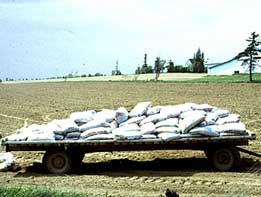
Believe it or not, more fertilizer goes on to intensively managed lawns than to most fields of potatoes (above) and grain! If clippings are recycled, fertilizer applications can usually be greatly reduced from commonly recommended levels.
|
Fertilizing modestly with nitrogen has many important benefits (compared to excessive fertilization), amongst them:
- fertilizing modestly reduces the growth of grass and demand for water;
- fertilizing modestly helps to reduce the thatch problem;
- fertilizing modestly, by making the grass less succulent, makes the grass less attractive to chinch bug and to many other pests and diseases.
(See Section IV for more details about effects of nitrogen.)
Here are some key points about N fertilization*:
- Focus on the fall as the key time to apply nitrogen fertilizer. The default application should be 0.5 to 1 lb N per 1000 sq ft (0.25 to 0.5 kg N/100m2) as a 'dormant feed' applied in late October through November.[L6] 'Dormant' feed means applying nitrogen when growth of the grass blades has largely stopped, but the grass is still photosynthesizing and shunting the nitrogen to the roots. This application strengthens the roots and results in early 'greening up' in the spring.[L21, L29]
On long established lawns on which clippings are retained, even that application may not be needed; as a rule of thumb if the grass is dark green in the late fall, it doesn't need it a dormant fertlization.
- Make other applications of nitrogen when the grass looks in need of it indicated by light green coloration. These other times could be the late summer/early fall when grass growth is resuming after the mid-summer slowdown and end of May/early June when growth is gearing up in the spring; 0.5 lbs N per 1000 sq ft (0.25 kg N/100 m2) could be applied at one or both of these times according to appearance of the grass.
- Use low grade, slow release or organic fertilizers.
Use a fertilizer with at least 75% of N in a slow release form, OR use a fertilizer with 5 to 10% N (avoid high grade N fertilizers); as available and affordable, use an organic fertilizer with 5 to 10% nitrogen, e.g., products based on feathermeal.
- Balance other nutrients and provide lime as indicated by soil tests. Lawns that have been regularly fertilized with mixed fertilizers or with organic fertilizers often have high levels of phosphorus. Depending on the soil mineralogy, they may have low pH, which reflects a low content of calcium and magnesium, and low potassium. The generally thin, non calareous soils of urban lawns in the Maritimes, where the high rainfall leachs the more soluble nutrients, usually require regular supplements of lime and potassium, but not of phosphorus.
*The amounts of nitrogen recommended for lawns in HRM above are considerably more conservative than those reported in most extension bulletins, They are based on two sets of field experiments carried at the Oaks in South end Halifax over a period of 7 years. The full details are in a report and a thesis in local libraries.[L6, L7] Readers should consult the links below and other sources for different perspectives, also for information about other fertilizers (P, K. lime etc.) Most importantly, I suggest, just experiment with reduced fertilizer applications on the lawn, more can always be added if the grass turns out to be really nitrogen deficient. - dp
4. Fall Clean-up
Make a point of raking away leaves and removing other litter on the lawn and in adjacent areas to reduce the amount of overwintering habitat for chinch bug. It also lessens the work required in the wet days of spring.
5. Aeration and Dethatching
These two practices are appropriate when there has been a chinch bug problem AND there is excess thatch (more than one half inch or 1.2 cm). They are fairly drastic measures and should be conducted only at times of year when the grass is not stressed and when there are 30 days or more of good growing weather ahead, i.,e. in spring or late summer.
Aeration
Aeration involves removing plugs of soil which are left on the soil surface to break down naturally.
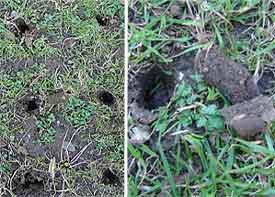 Aeration reduces compaction and opens up the soil for access by air and water. It helps to reduce thatch by removing it and breaking it up and mixing it with soil, and by accelerating soil biological activity. Aeration reduces compaction and opens up the soil for access by air and water. It helps to reduce thatch by removing it and breaking it up and mixing it with soil, and by accelerating soil biological activity.
Aeration is less drastic than dethatching. It's normally done in early spring or in the fall. Timing of aeration can be extended further into the spring than dethatching.
Immediately following aeration is a good time for adding organic fertilizers and lime some of which will wash into the holes; and for overseeding; then the soil plugs should be broken down by raking them to make a mulch.
Usually aeration is conducted with a power tool by professional landscapers (or rented), but manual, foot operated tools are also available.
Aeration should NOT have to be repeated every year. It is most valuable on heavier (clayey) soils with low organic matter. Too oft-repeated aeration can cause compaction and too rapid breakdown of soil organic matter.
Consult articles listed under Links below for more details about aeration and other types of turfgrass cultivation.
Dethatching
In the context of chinch control, the prime purpose of dethatching is to get rid of habitat for chinch. It has other benefits, e.g. it increases water uptake, and provides a better seedbed for overseeding.
Dethatching is a more drastic treatment that aeration, and should be undertaken only in early spring (to about May 15) or early fall when there are several weeks of cool weather and good growing conditions ahead to allow recovery of the grass.
Often dethatching is followed by aeration. Overseeding is advisable following dethatching. Its also a good time to topdress with soil and organic matter and (Control: Redesign) and to add lime.
Dethatching can be done by vigorous raking with a stiff rake, however, for larger areas, the use of commercial machines will be appreciated!
Consult articles listed under Links below for more details about dethatching, also see Section IV Factors on this website for a discussion of the causes and effects of thatch.
6. Links
Watering
-
Sustainable Turf Manual (http://www.nbhta.ca/english/sustainable_turf_manual.html) The Landscape New Brunswick Horticultural Trades Association, Spons.
Jack Wetmore and Ken Browne, Auths. (Viewed 16 May 2007). Individual chapters are available online as PDF documents. Chapter 6: Maintaining Turf contains a lot of practical information on water stress and the ins and outs of efficient use of water on lawns.
- Maintaining Lawns on Sandy Soils (PDF Doc) (http://www.agry.purdue.edu/turf/pubs/agry-98-03.pdf) Purdue Turfgrass Science Program, Spons. Z. Reicher and C. Throssell, Auths. (2003, March. Viewed 16 May 2007).
- Irrigation Practices for Homelawns
(http://www.agry.purdue.edu/turf/pubs/ay-7.pdf)
Purdue Turfgrass Science Program, Spons.; Z. Reicher and C. Throssell, Auths. (1998, March. Viewed 16 May 2007).
-
Turf Irrigation Efficiency in the Landscape (www.turfmagazine.com/articles/irrigation.html) Turf Magazine, Spons.; J. C. Fech, Auth. (2003, September 21. Viewed 16 May 2007)
The subtitle is 'Tips and tactics towards proper watering practices'. The article is written
for professional landscapers but is largely non-technical and useful to everyone
Mowing
- Importance of Proper Mowing
(www.urbanext.uiuc.edu/lawnchallenge/lesson4a.html)
University of Illinois Extension, Spons, 'Take the Lawn Challenge' Series. (Viewed 16 May 2007).
-
MOW DOWN AIR POLLUTION
(www.aqmd.gov/tao/lawnmower.html)
South Coast Air Quality Management District, Spons.
(Viewed 16 May 2007).
A program for going electric, however note that cordless electric mowers have recently been shown to emit large amounts of lead over their life cycle - so be sure to follow up on the disposal end if you buy one. [L36]
- Guide to choosing and using a manual reel mower
(http://www.reelmowerguide.com/) (Viewed 16 May 2007).
Some helpful hints about using reel mowers and information on particular models. (However ignore the "The Myth of the Three Inch Cutting Height" comments - even the turf experts agree that there are major benefits to cutting high, and it's essential for reducing water stress and controlling chinch bug without pesticides.)
- Scytheconnection (www.scytheconnection.com). Peter Vido and others, Auths. (Viewed 16 May 2007).
This site, by the Vido family of New Brunswick, provides many details about selecting and using scythes, health and environmental aspects of scything, courses and competitions, and applications of the scythe to conservation of biodiversity.
Fertilizing lawns
- Sound Fertilizer Practices
(www.urbanext.uiuc.edu/lawnchallenge/lesson4b.html)
University of Illinois Extension, Spons, 'Take the Lawn Challenge' Series. (Viewed 16 May 2007)
- Fertilizing Established
Lawns (http://www.agry.purdue.edu/turf/pubs/ay22.htm) Purdue Turfgrass Science Program, Spons. ; Z. Reicher and C. Throssell, Auths. (Updated 1998. Viewed 16 May 2007)
- Winterizing Turf (www.omafra.gov.on.ca/english/crops/facts/wintturf.htm)
OMAF (Ontario Ministry of Agriculture and Food), Spons. (2003. Viewed 16 May 2007)
- Nutrient Management (PDF document) (http://dp.biology.dal.ca/cog/BCgrower.pdf) BC Organic Growers, Spons., D. Patriquin, Auth. (2003. Viewed 16 May 2007). An article about nutrient management using organic fertilizers.
Aeration and Dethatching
- Turf 101: Thatch
(www-p.afsv.af.mil/Golf/MaintenanceDocs/TurfandThatch.doc) PURDUE TURFGRASS PROGRAM Turf Tips, TURF TIP 5/14/03. Z Reicher, Auth. (2003, May 14. Viewed 16 May 2007)
A photograph on this page shows the thatch layer being measured. Note that the thatch layer is the dark brown, peaty layer, NOT the light brown, dead grass on the surface of the soil.
- Turfgrass Cultivation and Thatch Control(www.turf.uiuc.edu/extension/ext-cult.html) University of Illinois at Urbana Turfgrass Program, Spons.; T. Voigt and T Fermanian, Auths. (Viewed 16 May 2007).
Good discussion of different types of turfgrass cultivation equipment including alternatives to aerators that can be used to mix soil and thatch.
- Thatch-a hidden lawn concern (PDF document)
(www.oznet.ksu.edu/library/hort2/MF2131.PDF) Kansas Sate University Agricultural Experiment Station and Cooperative Extension Service, Spons. ; M. Fagerness, Auth. (Horticulture Rept: Turfgrass MF2131)
(2001. Viewed 16 May 2007).
Advice on thatch thickness and frequency of detatching; aerating and dethatching tools.
- Thatch Control in Turf (PDF document)
(pubs.caes.uga.edu/caespubs/pubs/PDF/L394.pdf)
Cooperative Extension Service/The University of Georgia College of Agricultural and Environmental Sciences, Spons.; G, Landry, Jr. Auth. (Viewed 16 May 2007).
General guidelines for reducing thatch; aerating and dethatching equipment
Site posted 5 Apr. 2004
Links updated 16 May 2007
Minor edits 4 July 2007
|
 Aeration reduces compaction and opens up the soil for access by air and water. It helps to reduce thatch by removing it and breaking it up and mixing it with soil, and by accelerating soil biological activity.
Aeration reduces compaction and opens up the soil for access by air and water. It helps to reduce thatch by removing it and breaking it up and mixing it with soil, and by accelerating soil biological activity. 